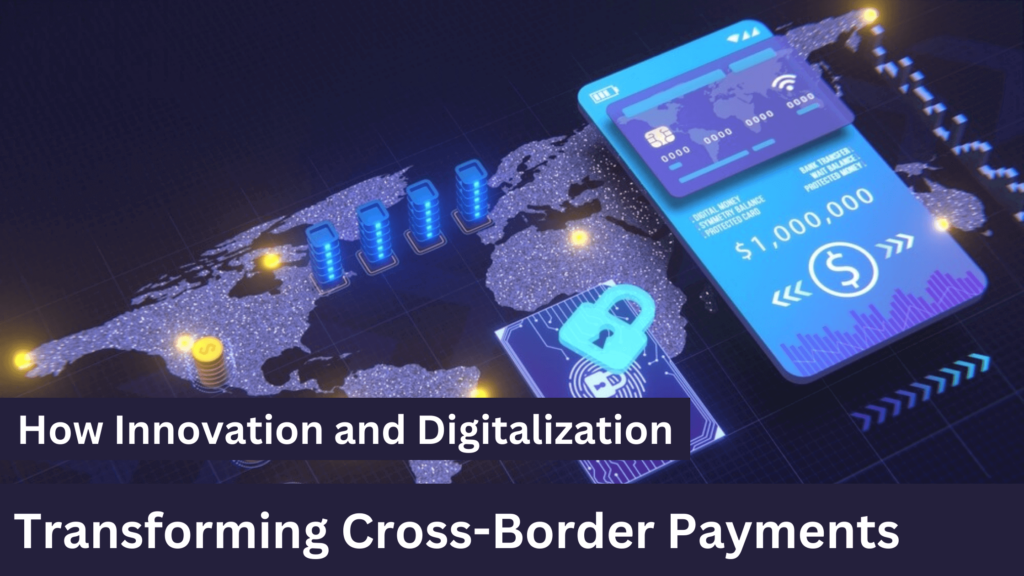Have you ever wondered how innovation and digitization are revolutionizing the landscape of cross-border payments? In today’s interconnected world, cutting-edge technologies are rapidly replacing traditional payment methods.
These transformed technologies streamline transactions, enhance security, and improve efficiency. These advancements, from SWIFT gpi to digital wallets, are reshaping how businesses and individuals transfer funds across Cross-Border Payments. Read this post and get to know how innovation and digitization are transforming cross-border payments.
What is a cross-border payment?
Cross-border payments occur when the sender and recipient are in different countries. It allows transactions among individuals, businesses, and financial entities across international borders. Do you know? Cross-border payments are expected to exceed $250 trillion by 2027, becoming one of the fastest growing industries in the global payments environment.
How Innovation and Digitization are Transforming Cross-Border Payments
Here are the most notable innovations and digitization which are transforming cross-border payments:
- Cross-Border Payments Innovations
Do you know how traditional cross-border payments work? This system is based on antiquated technologies, which has prompted the development of creative solutions. Before delving into them, it is critical to grasp the current landscape.
Wire transfers are one of the oldest means of cross-border fund transmission. They rely on SWIFT codes and recipient information to complete transactions. Despite their durability, they have slow processing rates, which might take days, and can make it difficult to resolve abnormalities quickly.
As a result, in recent years, there has been an increase in disruptive alternatives targeted at updating burdensome legacy systems.
- SWIFT global payments initiative
The next innovation in cross-border payments is the SWIFT global payments initiative. SWIFT gpi was launched in 2017 and has now been used by over 4,200 banks and 60 market infrastructures. SWIFT gpi seamlessly connects domestic real-time payment networks, allowing near-instant cross-border transactions that are not limited by bank operation hours. Using existing message protocols and bank payment systems, it quickly adjusts to changing conventions while remaining efficient and affordable.
It is built upon four essential principles:
- Processing payments on the same business day.
- Real-time tracking of payment status.
- Ensure fee clarity throughout the payment procedure.
- Sending unaltered remittance information that appropriately identifies the purpose of the payment.
SWIFT GP is guaranteed access to the GPi tracker data, which streamlines information availability that was previously dependent on numerous counterpart apps. Banks may now share transaction details directly with clients, with a complete API connection for smooth tracking within their treasury management tools, increasing transparency and efficiency.
- Digital wallets
Another innovation and digitization in cross-broader payment is the digital wallet. Yes!! Everyone is familiar with the word digital wallet. With the increasing number of smartphones and breakthroughs, developments, and innovations in secure mobile payment technology, the digital wallet has emerged as a vital component of cross-broader payment.
Believe it or not, Digital wallets have greatly impacted cross-border payments. Global digital wallet volume is expected to exceed $12 trillion annually by 2028.
They offer multi-currency capabilities and eliminate local account requirements, resulting in faster, cheaper, and more accessible transactions. By collaborating with a worldwide digital wallet provider, retailers can handle more real-time foreign currency payments.
- Money transfer organizations (MTOs) and cross-border payment networks
The Payment Services Directive 2 (PSD2) rule has significantly impacted money transfer organizations and cross-border payment networks. This regulation has fueled innovation in cross-border payments, most notably through open banking APIs.
Payers can use these APIs to bypass traditional correspondent banking networks and establish direct links with partners. This transition allows for faster and more adaptable cross-border payments solutions, which improves efficiency and flexibility for organizations and individuals involved in international transactions.
The transition to open banking APIs is a watershed moment in the history of cross-border payments, ushering in a new era of simplified and agile financial transactions worldwide.
- Real-time payment (RTP) rails going global
Traditional banking systems usually fail to fulfill the global marketplace’s speed and efficiency requirements. Here comes the Cross-border real-time payments as a game changer!! This transforms international trade by breaking down obstacles and moving global business forward.
Real-time payments have transformed financial transactions, allowing for near-instantaneous fund transfers worldwide. Real-time payments significantly speed up transactions, lowering processing times from days to seconds and improving global trade supply chain efficiency and liquidity.
Furthermore, they provide cost-effective alternatives, including competitive exchange rates and lower fees, protecting businesses’ revenues from exorbitant banking fees.
Distributed ledger technology-based cross-border payments
In the ever-changing world of financial technology, Distributed Ledger Technology is emerging as a disruptive force, particularly in cross-border transactions. This technology, best known for underlying cryptocurrencies like Bitcoin, is rapidly being utilized by banks and financial organizations to upgrade their existing systems.
Banks are using Distributed Ledger Technology, such as D3 Labs, for cross-border transactions because of its benefits. DLT improves security and transparency by decentralizing transaction records, which reduces fraud risks.
It also reduces transaction times and costs by allowing direct transactions while eliminating intermediaries. Furthermore, DLT improves traceability and compliance by providing immutable transaction records, which help banks satisfy regulatory criteria and combat financial crimes.
Competition between SWIFT and Ripple
The competition between SWIFT and Ripple is based on major aspects such as transaction speed, cost-effectiveness, and network reach.
While SWIFT has a global network of over 11,000 financial institutions, Ripple provides faster transaction rates, processing transfers in seconds rather than up to five days. Regardless of the amount transmitted, Ripple’s flat transaction price of $0.0002 adds to its appeal.
Ultimately, the decision between SWIFT and Ripple is based on personal preferences, with SWIFT’s established reputation and extensive network contrasting with Ripple’s speed and cost-effectiveness in cross-border payments.
The big promise of central bank digital currencies (CBDC)
Central bank digital currencies can potentially transform cross-border payments by addressing current network interconnection concerns. CBDCs enable cooperation between different national designs, decreasing intermediation and increasing efficiency and safety.
CBDCs are currently in use in five countries, with an additional 81 researching the concept. In October 2020, the Bahamas Central Bank led the way with the Sand Dollar.
Industry leaders such as Mastercard, Citi, PayPal, ConsenSys, and J.P. Morgan actively support CBDC innovation. CBDC testing platforms, government alliances, and wholesale CBDC cross-border payment trials are among the initiatives, all indicating a significant shift in the financial landscape.
As quick as lightning
The increasing adoption of innovative cross-border solutions from fintech and payment networks signals a diminishing need for traditional correspondent agents and intermediary banks in cross-border payments.
This trend is evident even without the anticipated frictionless system promised by CBDCs. As technology evolves, streamlined and efficient payment processes are reshaping the landscape, reducing reliance on traditional intermediaries and paving the way for a more direct and seamless global financial ecosystem.
The Bottom Line
Fintech companies are transforming cross-border payments through technology and innovation. From providing global payment solutions and digital payment systems to assuring security and streamlining international money transfers, these organizations are changing how people and businesses move money across borders. As technology advances, we may expect greater developments in Cross-Border Payments, with fintech companies paving the way for a more efficient and inclusive global financial environment.
FAQs
How can businesses optimize cross-border payment processes?
By leveraging technology, adopting efficient payment platforms, and staying informed about regulatory changes, businesses can streamline cross-border payments and reduce costs.
What are the benefits of real-time cross-border payments?
Real-time payments offer instant settlement, lower costs, and enhanced transparency, providing businesses and individuals with greater control over their international transactions.

